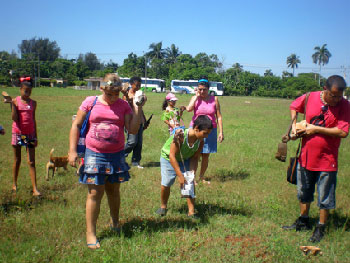Recovering a Small Forest in Santa Fe, Cuba
Isbel Diaz Torres (Photos: Jimmy Martinez)

HAVANA TIMES — Since acting as the representative of her community in an effort to recover a grove of casuarina trees in Santa Fe that had been felled by authorities, my restless friend Patricia Alonso has continued to insist that autonomous community work is possible and to try and involve her neighbors in the exploration and transformation of their environment.
As part of the activities organized last summer by the Santa Fe Museum (where Patricia currently works), she set out to plant a silk-cotton tree in the forest area that had been razed to the ground with the aid of the EL GUARDABOSQUES (“THE FOREST RANGER”) Project and her neighbors.
With the aid of my friend Luisito (a tireless environmentalist), I managed to get my hands on a silk-cotton (ceiba) true seedling. It made the long journey from Vedado to San Agustin, and from there to Santa Fe, where local children were finally able to plant it in the enormous, formerly wooded area.
Since the military personnel responsible for felling the trees returned the lot to the community, the area has been partially reforested with different indigenous tree species, such as majagua, ocuje, almond trees and others. The silk-cotton tree was the most recent addition.

It is not advisable to delay such reforestation efforts, as the summer rains have already encouraged the growth and proliferation of marabou weed plants, which have surreptitiously begun to spread across those areas still to be reforested.
It was gratifying, for me and my partner Jimmy, to see local children throw themselves enthusiastically into the tree planting effort. Children never cease to surprise us. Many a time, we need only stand back and let them work.

It was also a great pleasure for us to see adults, who have become aware of environmental issues, join the effort. Of their own initiative, they have taken great care of the area, where children and teenagers are once again playing.
This was not, to be sure, the only campaign undertaken as part of the Santa Fe Museum’s summer workshops (titled “Getting to Know my Community”). Community members also visited the beautiful (though excessively visited) Bajo de Santa Ana mangrove swamp, as well as the Lamas cave and other places of historical and ecological interest.
I commend Patricia and her colleagues at the Museum. I sincerely hope they call us again for another tree-planting effort.






plants those trees!